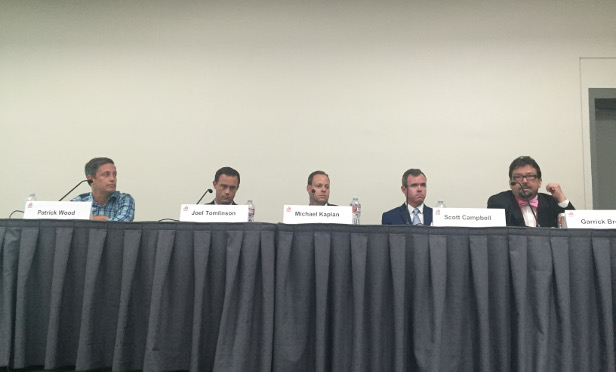 Garrick Brown (far right) gave his predictions on the next hot net-lease categories.
Garrick Brown (far right) gave his predictions on the next hot net-lease categories.
SAN DIEGO—While there are several “hot” product categories for net-leased properties and the sector continues to be robust, each piece of real estate has to be evaluated on its own merit, said panelists at ICSC Western Conference & Deal Making’s “Triple Net Lease Program” session here Tuesday. The panelists gave their views on the current state of the sector, where they believe it’s heading and what investors should watch out for before buying.
The strongest categories for triple-net-leased, single-tenant properties are restaurants—fast food, fast-casual and casual being the strongest—grocery stores, drug stores, discount/dollar stores and healthcare, panelists said.
Garrick Brown, VP of retail research for Cushman & Wakefield, said the problem with people looking at only one category of retail when evaluating the sector’s strength is that they paint it with a broad brush; just because the department-store and big-box categories are currently struggling doesn’t negate the robust business seen in the categories mentioned above. He points out that dining out has become one of the country’s favorite pastimes. “American people spent more money on eating out than eating in in the last two months.” He said since restaurants is a strong net-lease category, “nothing but the weakest product will see cap rates go up.” He also said the grocery category has seen an “explosion of growth, with stores like Aldi helping to fill in spaces vacated by previously unsuccessful grocery chains. Discount small-format stores have about two years left in the cycle, but it is otherwise solid, he added.
Joel Tomlinson, SVP, acquisitions, for Realty Income Corp., said the demand for core, quality, low-risk assets is great. He sees a softening of cap rates among B- and C-rated credit tenants and said the non-traded REIT business “changed our business,” with the supply/demand imbalance caused by the recession leading to cap-rate compression. However, “this space is almost non-existent now.” Consolidation among non-traded REITs has caused them to subside as competitors in the net-lease space.
Michael Kaplan, COO of Barry Slatt Mortgage, said among the three major drug-store chains—CVS, Walgreens and Rite-Aid—lenders like them in that order. The overlap in the market may be resolved by a likely merger between Walgreens and Rite-Aid.
One of the challenges to buying net-leased properties in California as opposed to other markets is the amount of time it takes to get a property entitled, which is “six to 12 months longer than we’re used to,” said Patrick Wood, president of Wood Investments Inc. “You have to be ready to deal with that.”
Scott Campbell, associate director of Calkain Cos., said when investors see how much more yield they can get on their net-leased investment by going outside of California, they often take the plunge. Similarly, a lot of South American money comes into Florida, where he is based, but these investors want to be in Miami; however, when they see the yield they can get on properties in Northern and Central Florida, they make the move. “South American borrowers see Florida as a stable option and are willing to pay 5 caps” on net-leased properties. He’s also seeing a lot of New York 1031 money coming into Florida, he said.
Regarding interest rates, Kaplan said he doesn’t see movement on the long end of the curve. “I think we’ll be in a relatively flat space for 12 to 18 months.”
When discussing Millennials’ impact on net-leased real estate, Brown said the key is to provide Millennials with authentic dining options—whether it be fast food, fast-casual or casual dining—and curated retail rather than “1,100 Gaps” that are all the same all over the country. Innovative and outside-the-box retail is what draws in young customers, and he expects to see “more bad news from traditional brands.”
Wood said drive-thru retail is quite valuable, as well as the discount market. While drive-throughs are hard to entitle, the projects are invaluable since lenders see them as safe investments.
In secondary and tertiary markets, the more competitive lenders tend to be credit unions and community banks, said Kaplan. He urged borrowers to consider alternative options to their own bank that might offer better loan terms. However, they’re hard to find in some secondary and tertiary markets.
Tomlinson warned investors about short-term debt, calling it a loaded gun and dangerous. “You get what you pay for in this market.” He added that it’s “not worth it to focus on credit” and to buy at or below market rents. Kaplan added that most lenders are really looking at the real estate, so be sure the asset is of good quality and in a good market first. “Think hard about what you’re buying,” said Tomlinson.
Wood added, “There is an art to this business. You have to take all considerations into account; all the pieces need to mesh.”
Moderator Matthew McNeill, VP of Cushman & Wakefield, advised to “buy in a good area or an area where you see some value.”
Panelists discussed the strength of the dollar-store sector, and Brown said a new dollar store opens in the US every four hours. “Lenders love dollar stores, but you still have to be careful about the credit issue. Is there this much room for this many dollar stores?” There’s still enough imminent runway for many retail categories, “but some categories don’t have much left—the dollar store is one of them.”
Looking ahead, Brown said he sees a slew of office-supply properties coming back to the market with the shakeups stores like Sports Authority have seen. Urgent care and other medical facilities are strong bets, and he expects to see someone in that field trying to pick up some of that space.
Kaplan said he sees different medical groups aligning with major hospitals and collaborations between the large medical groups and merchant buildings to go in and find space. The healthcare field is intrinsically strong, he added—“dialysis is not going anywhere”—and these tenants are good long-term lease options. McNeill added that with equipment in their space that’s expensive to move, these tenants stay for the long term.
Tomlinson said his firm has a lot of DaVita and Fresenius properties in its portfolio, but the assets vary across the board. “We have stayed away from urgent care since the credit is not as good.”

















 Copyright © 2024 ALM Global, LLC. All Rights Reserved.
Copyright © 2024 ALM Global, LLC. All Rights Reserved.